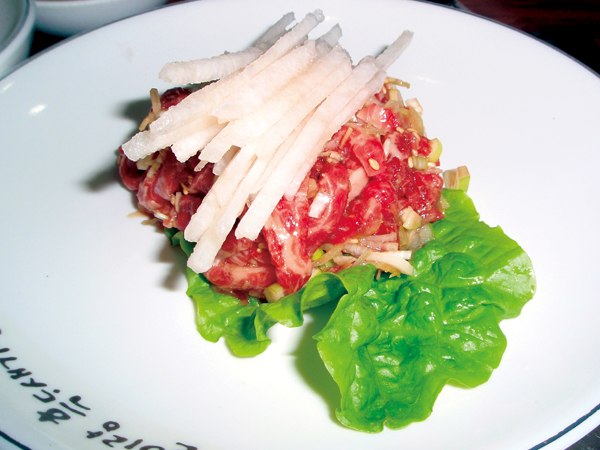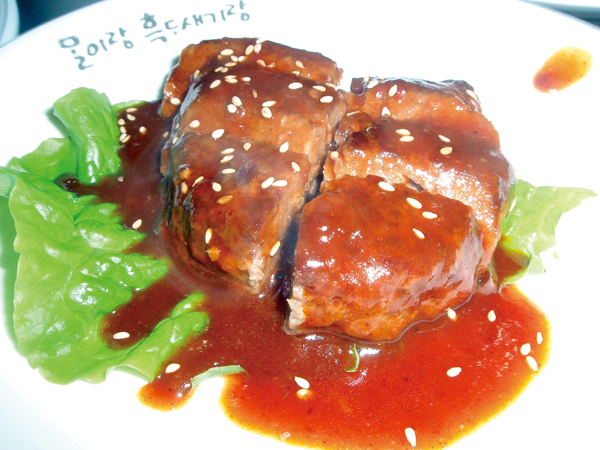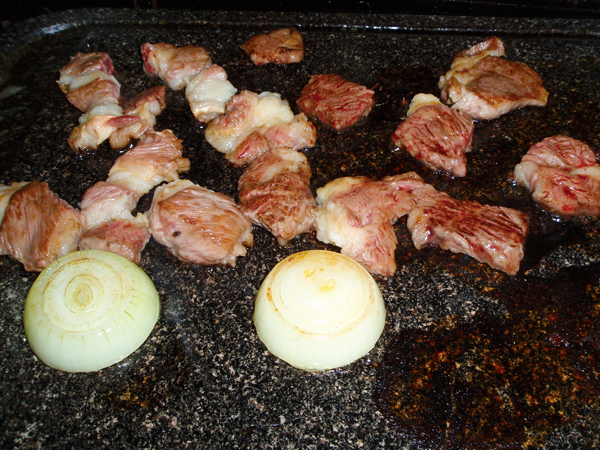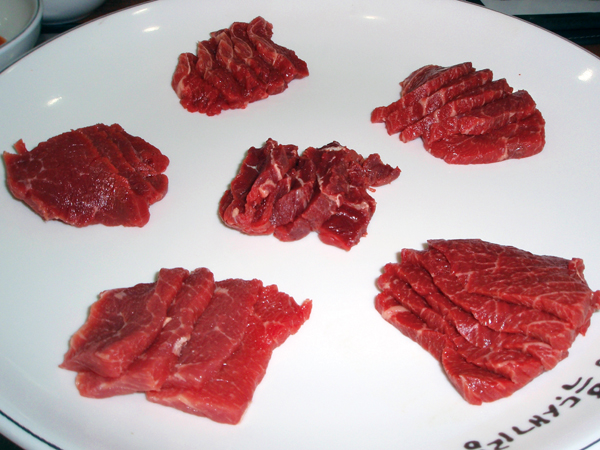
- Updated 2024.4.24 17:16
- All Articles
-
member
icon
-
facebook
cursor
-
twitter
cursor
| |
 |
|
| ▲ The idea may not be appetizing to some, but horse, once considered a delicacy by Korean nobles, is served in a variety of ways at the Malirang Heukdosaegirang restaurant near Shin Jeju. Photo by Steve Oberhauser |
I had no idea what I was getting myself into. Neither did my Jeju native dinner guest. However, I’m no stranger to bizarre meats. And, luckily, my friend is adventurous — a female rendition of Zorba.
We settled on the 14-part, special horse course at one of the island’s finest horse meat restaurants, Malirang Heukdosaegirang, about 10 minutes south of Shin Jeju. Owner Pak Hee Jeong and her husband Kim Jin Uk have an all-inclusive set-up. The horses come from their farm, are processed every Wednesday and Friday, and end up raw and tender on the serving plates to be immediately consumed or grilled. After finishing dinner, there are countless horse cosmetic products from which to choose.
The meal starts with ekgiseu. Processed in the restaurant’s basement, red horse bone juice, in a plastic cup, is served next to a tiny dish of ground horse bone powder. “Mix! One-shot!” one of the servers explained. After mixing with a chopstick and gulping, the traditional medicine-tasting concoction felt grainy going down.
From this rather unassuming start, the first dinner platter of yuksashimi, or raw horse meat, was incredible. Three different slices were offered: sirloin, rib, and the side. Once it touched the lips, glorious. There was little need to chew. Almost no fat. Milder than beef, it was soft and had a slightly sweet taste.
| |
 |
|
| ▲ Photo by Steve Oberhauser |
The horse parts on the plates come from the short, stocky Jeju kind, known as Jejuma. Throughout Korean history, horse meat was served to the king, as it was seen as a prime delicacy. In addition, the fat from horse meat contains unsaturated fatty acid, producing better health benefits than that from other meats.
But back to eating.
Yukhoe, another form of raw horse meat, was next. This horse meat was cut thick, shoe-string size, mixed with sesame oil and garlic, all topped with thinly sliced pears. Heavenly. It didn’t last long.
Soon, the server was back again and recommended putting a bit of heat to the few, leftover raw slices of horse. We did. And, although it was perfectly fine though a bit tough, the cover went back on the grill. Raw is best.
Servings of horse liver soon made an appearance and this was where looks were deceiving. It seemed it would break apart easily. On the contrary, it was rubbery, but palatable.
Throughout the dining fare, three different soups were produced. A large pot of abalone soup, a smaller serving of steamed galbi and individual servings of thick horse beef soup with rice. All good.
| |
 |
|
| ▲ Photo by Steve Oberhauser |
We soon lost track of the many plates that were cluttering the table. The regular Korean side dishes were getting pushed off far in the distance. There needed to be more room for the cylindrical inner organs, gravy-smothered steak, and bulgogi. The grill cover came off once again.
Overwhelming.
Although the 14-part course is priced at 50,000 won per person, there is a 10-part A course for 30,000 won and the 20,000 won B course which comes with seven offerings. Individually, there are also 11 different horse items, priced anywhere from 12,000 to 50,000 won.
The last food surprise — and was it a big surprise — turned out to be the two final, on-the-house dishes.
Because the bone marrow and kidney mix dish is only served Wednesdays and Fridays after horse processing, the server brought us four slices of horse tongue on one plate. Thick. Slabs of goodness, like smoked ham.
| |
 |
|
| ▲ Photo by Steve Oberhauser |
“Delicious,” Zorba said.
The other plate? Well, let’s just say, there were six slices of a horse part that is used to create other horses. Bland as banana chips with no sweetness. Rather tasteless in fact. Apparently, according to several workers, a full platter of this fetches 200,000 won.
I’ll admit to eating meats such as squirrel, rabbit, caribou, ostrich, alligator and nutria. Yet, that last plate may prove to be a bitter pill to swallow, mentally. The full horse course though was an unforgettable experience.
Without reservations, savor and devour Jejuma meat.
|
|
|
|
|
|
|
|
ⓒ Jeju Weekly 2009 (http://www.jejuweekly.net)
All materials on this site are protected under the Korean Copyright Law and may not be reproduced, distributed, transmitted, displayed, published without the prior consent of Jeju Weekly. |
|
|
|
|
| Jeju-Asia's No.1 for Cruise |
|
|
|
Title:The jeju Weekly(제주위클리) | Mail to editor@jejuweekly.net | Phone: +82-64-724-7776 Fax: +82-64-724-7796
#503, 36-1, Seogwang-ro, Jeju-si, Jeju-do, Korea, 63148
Registration Number: Jeju, Ah01158(제주,아01158) | Date of Registration: November 10,2022 | Publisher&Editor : Hee Tak Ko | Youth policy: Hee Tak Ko
Copyright ⓒ 2009 All materials on this site are protected under the Korean Copyright Law and may not be reproduced, distributed, transmitted, displayed, published
without the prior consent of jeju weekly.com.

|























